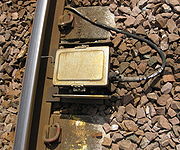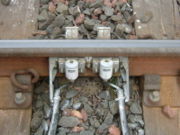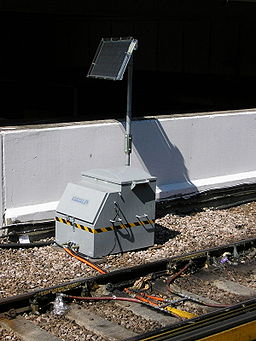
Treadle (railway)
Encyclopedia

Railway signalling
Railway signalling is a system used to control railway traffic safely, essentially to prevent trains from colliding. Being guided by fixed rails, trains are uniquely susceptible to collision; furthermore, trains cannot stop quickly, and frequently operate at speeds that do not enable them to stop...
, a treadle is a mechanical or electrical device that detects that a train axle has passed a particular location. They are used where a track circuit
Track circuit
A track circuit is a simple electrical device used to detect the absence of a train on rail tracks, used to inform signallers and control relevant signals.- Principles and operation :...
requires re-inforcing with additional information about a train's location, such as around an automatic level crossing
Level crossing
A level crossing occurs where a railway line is intersected by a road or path onone level, without recourse to a bridge or tunnel. It is a type of at-grade intersection. The term also applies when a light rail line with separate right-of-way or reserved track crosses a road in the same fashion...
, or in an annunciator circuit, that sounds a warning a train has passed an exact point. The important difference between a treadle and a track circuit
Track circuit
A track circuit is a simple electrical device used to detect the absence of a train on rail tracks, used to inform signallers and control relevant signals.- Principles and operation :...
is that while a track circuit detects a train over a distance as long as several kilometres, a treadle provides pin-point detection.
Mechanical
In situations where track circuits are unreliable due to rusty rails, for example adjacent to buffer stops and catchpoints, a long treadle bar is used. When this is depressed, the signalman gains indication (if he has not already done so) of a train in a section.Electro-Mechanical
An electro-mechanical treadle retains a small arm that lies across the flangeway of a rail. When it is depressed, an electrical circuit controller within the unit changes its output. It remains depressed for a period of several seconds, so that a train with many axles does not unduly damage the unit.Electronic

Axle counter
An axle counter is a device on a railway that detects the passing of a train in lieu of the more common track circuit. A counting head is installed at each end of the section, and as each axle passes the head at the start of the section, a counter increments...
circuits that can replace track circuits completely.
Variations
Variations on a treadle that can be carriage long include facing point lock bars, clearance bars, and train bars, depending how they are located on a track layout.Reverser
A mechanical treadle that puts a signalRailway signal
A signal is a mechanical or electrical device erected beside a railway line to pass information relating to the state of the line ahead to train/engine drivers. The driver interprets the signal's indication and acts accordingly...
to 'stop' can be replaced by a short track circuit
Track circuit
A track circuit is a simple electrical device used to detect the absence of a train on rail tracks, used to inform signallers and control relevant signals.- Principles and operation :...
and a reverser. A reverser is an electrically engaged latch that allows the signal to be reversed, i.e. placed to green. When the track circuit past the signal is occupied, power to the latch is removed, and the signal reverts to 'stop', red.
Reversers have been used in New South Wales
New South Wales
New South Wales is a state of :Australia, located in the east of the country. It is bordered by Queensland, Victoria and South Australia to the north, south and west respectively. To the east, the state is bordered by the Tasman Sea, which forms part of the Pacific Ocean. New South Wales...
especially to put starting signals to stop. When the signal was put back to stop, the system automatically sent the train on line bell signal (two bells) to the station in advance. This equipment would have helped prevent the Hawes Junction rail crash
Hawes Junction rail crash
The Hawes Junction rail crash occurred on 24 December 1910, on the Midland Railway's Settle and Carlisle mainline at the junction with the Wensleydale Railway in Westmorland , England. It was caused when a busy signalman forgot about a pair of light engines waiting at his down starting signal to...
.
Level crossing
Treadles are commonly used to operate fully automatic level crossingLevel crossing
A level crossing occurs where a railway line is intersected by a road or path onone level, without recourse to a bridge or tunnel. It is a type of at-grade intersection. The term also applies when a light rail line with separate right-of-way or reserved track crosses a road in the same fashion...
s since they give far more reliable and accurate detection of a train than track circuits alone, which is important when there is only just over 30 seconds between the train "striking in" (passing the treadle which starts the crossing sequence) and passing the crossing.

Greasers
Greasers use a small treadle to apply a small quantity of grease to the inside edge of the rail to reduce friction and noise between the flange of the wheel and the rail.Accident
One early signal was the "Automatic" signal invented by CF Whitworth. Far from being "automatic" in operation, this was merely a signal that was operated by the signalmanSignalman (rail)
A signalman or signaller is an employee of a railway transport network who operates the points and signals from a signal box in order to control the movement of trains.- History :...
but returned to 'danger' once the train had passed, by means of a treadle. There was one of these at each end of Clayton Tunnel
Clayton Tunnel
Clayton Tunnel is a railway tunnel located near the village of Clayton, West Sussex between Hassocks and Preston Park railway stations on the Brighton Main Line...
, just north of Brighton, and it was the failure of the signalman to see that the signal had not returned to danger that led to the worst ever accident on that railway. Because the signal had failed to return to stop, a second train entered the tunnel and collided with the first which had stalled.
The biggest flaw in the Whitworth automatic signal is probably that it had no redundancy, and a single stone might jam it. On the other hand, without a treadle, the signalman is more likely to get distracted and forget to put the signal to stop.
See also
- Track circuit interrupterTrack circuit interrupterA track circuit interrupter may be fitted at catch points, trap points or buffer stops to maintain a track circuit in the 'occupied' state in the event of a derailment. The track circuit remains de-energised until the interrupter is replaced....
- Languages
- Induction loopInduction loopInduction loop is a term used to describe an electromagnetic communication- and detection system, relying on the fact that a moving magnet will induce an electrical current in a nearby conducting wire. Induction loops are used for transmission and reception of communication signals, or for...
used mainly for road and tram use.
External links
Altpro Treadle Ansaldo Treadle Ansaldo electronic Treadle Henry Williams Treadle Schweizer Electronic Treadle UnipartRail (GE) Treadle Kelly---- Reverser

